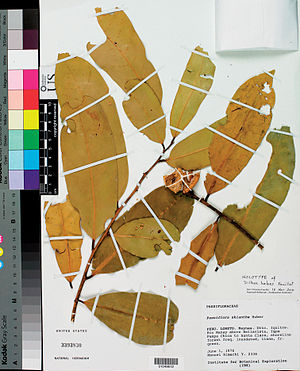Dilkea Hebes
| Dilkea Hebes | ||||||||||||
|---|---|---|---|---|---|---|---|---|---|---|---|---|

|
||||||||||||
| Systematics | ||||||||||||
|
||||||||||||
| Scientific name | ||||||||||||
| Dilkea Hebes | ||||||||||||
| Feuillet |
Dilkea hebes is a species of plant withinthe passion flower family (Passifloraceae). It was first described in 2011 and is native to eastern Peru.
description
Appearance and leaf
Dilkea hebes grows as a woody climbing plant . The bald axis of the shoot has almost the same to slightly different internodes . The twigs turn brown to black as they dry ( e.g. herbarium ). No stipules are formed.
The alternate and spirally arranged leaves are divided into a petiole and a leaf blade. The petiole, which is reduced to the pulvinus , is 3 to 6 millimeters long and thickened; it does not shrivel when it dries and it turns almost black. With a length of 7.5 and 19 centimeters and a width of 3.5 and 6.5 centimeters, the leathery leaf blade is narrowly elliptical to inverted-lanceolate with the widest point about two thirds in front of the base of the blade . The base of the blade narrows slightly to a point at an angle of about 45 ° to the central rib in the direction of the petiole and the upper end of the leaf blade is pointed or rounded and briefly pointed. The leaf margin is wavy in herbarium, possibly caused by the curved midrib. The matt top of the leaf turns dark olive-green when it dries and the matt underside of the leaf turns pale olive-green. The middle nerve is located on the underside of the leaf in a furrow and is strongly raised on the upper side of the leaf; 15 to 20 pairs of lateral nerves extend from it (with a fully developed leaf). Stipules were not seen by the author of the first description.
Inflorescence and fruit
The laterally racemose inflorescence contains one or two flowers. The inflorescence stem is thicker than the stem axis. The thick bracts are scale-like with a length of 0.5 to 2 millimeters and are long and narrow to short and wide under the same fruit. Nothing is known about the flowers, as none are present in the herbarium that has been sighted, but in the other species of this genus they are always four-fold and in the other species of this subgenus they are always white.
The inflorescence stem and stalk form a structure 0.5 to 1.5 centimeters long and 0.4 to 0.6 centimeters thick under the fruit. The fruits are spherical in shape. In collections in February and June, still unripe, green colored, but already well developed fruits were found. Their hard pericarp is cork-like and between 4 and 5 millimeters thick. Each fruit contains one or two seeds and is otherwise hollow, except for a few separating membranes. This could increase the buoyancy of the fruits and thus be an adaptation to their frequently flooded habitat. The somewhat asymmetrical seeds are peanut-shaped with a length of about 1.7 centimeters and a diameter of 0.7 to 0.8 centimeters.
Occurrence
The natural range of Dilkea hebes is in the province of Maynas in eastern Peru . The species thrives there at altitudes of around 90 meters. It grows in riparian forests which are often flooded.
Systematics
It was first described as Dilkea hebes in 2011 by Christian Feuillet in PhytoKeys number 2, page 2. The Latin epithet hebes means matt and refers to the color of the upper side of the leaf.
Dilkea hebes belongs to the subgenus Dilkea of the genus Dilkea Mast. from the tribe Passifloreae DC. in subfamily Passifloroideae Burnett within the family of Passifloraceae Juss. ex Roussel .
swell
- Christian Feuillet: Two new species of Dilkea subgenus Dilkea (Passifloraceae) from Loreto, Peru . In: PhytoKeys . No. 2 , 2010, ISSN 1314-2003 , p. 2-4 , doi : 10.3897 / phytokeys.2.722 .
Individual evidence
- ↑ a b c d e f Christian Feuillet: Two new species of Dilkea subgenus Dilkea (Passifloraceae) from Loreto, Peru . In: PhytoKeys . No. 2 , 2010, ISSN 1314-2003 , p. 2-4 , doi : 10.3897 / phytokeys.2.722 .
- ↑ Dilkea hebes. In: The International Plant Names Index. www.ipni.org, accessed on March 10, 2013 (English).